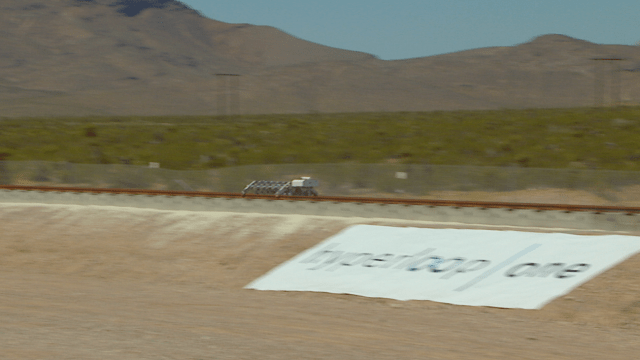A hyperloop startup has built the first full-scale test track for the transportation system in the desert outside Las Vegas. Today, Hyperloop One (formerly Hyperloop Technologies) accelerated a test vehicle down a rail track at speeds of up to 300 mph using the hyperloop’s propulsion technology. It looked like a really fast roller coaster.
Lead Image: Hyperloop One
World’s first hyperloop propulsion test pic.twitter.com/nbgJKHTvw9
— Jason Koebler (@jason_koebler) May 11, 2016
What are you looking at here? Using the linear-electric motor that will eventually accelerate a hyperloop pod, engineers orchestrated what they call a “propulsion open-air test,” or POAT. The test vehicle (nicknamed a “sled”) goes from 0 to 60 mph in about one second, generating a force of about 2.5Gs. (Update: Hyperloop One told those in attendance that it was about 0 to 160km/h in one second — also, the reason it plows into a pile of sand at the end is because they haven’t yet designed brakes.) Hypothetically, the same motor could enable a more aerodynamically designed vehicle to reach speeds of 1,120km/h in a very low-pressure tube.
And there goes #Hyperloop, accelerating to 2.5G #cbc pic.twitter.com/0R2WbBgEhM
— Kim Brunhuber (@kimbrunhuber) May 11, 2016
Yesterday evening I spoke with senior vice president of engineering Josh Geigel who confirmed the use of an electromagnetic propulsion system. Although Geigel could not say more about the technology before the test, he did speak with a reporter from Mashable about the test track’s motor:
Unlike typical motors, this one has no moving parts. Giegel described the motors as “blades” and what you might get if you took a typical electric motor, cut it down the seam and unrolled it. When powered, these roughly 60cm tall by 15cm wide blades create electromagnetic energy that reacts with the pod and pushes it along.
This makes it sound similar to a linear-induction motor you might see on newer roller coasters that shoot cars out at very high speeds — which is why the test looked like one of those roller coasters. But unlike the motors used on roller coasters or high-speed rail, the near-vacuum environment in the hyperloop’s tube reduces the need for so many of these motors because there’s less drag. As Geigel explained it to me, the motors would only need to be installed on 5 to 10 per cent of the track, about every 80km.
We’ll keep updating this post with more images and video as they become available.
The 700 mph #Hyperloop just got one step closer to reality. @HyperloopOne held its first test run.https://t.co/7o3JcaL7f3
— CNBC (@CNBC) May 11, 2016
And there goes the first Hyperloop test pic.twitter.com/44JObzfkno
— Steve Kopack (@SteveKopack) May 11, 2016
